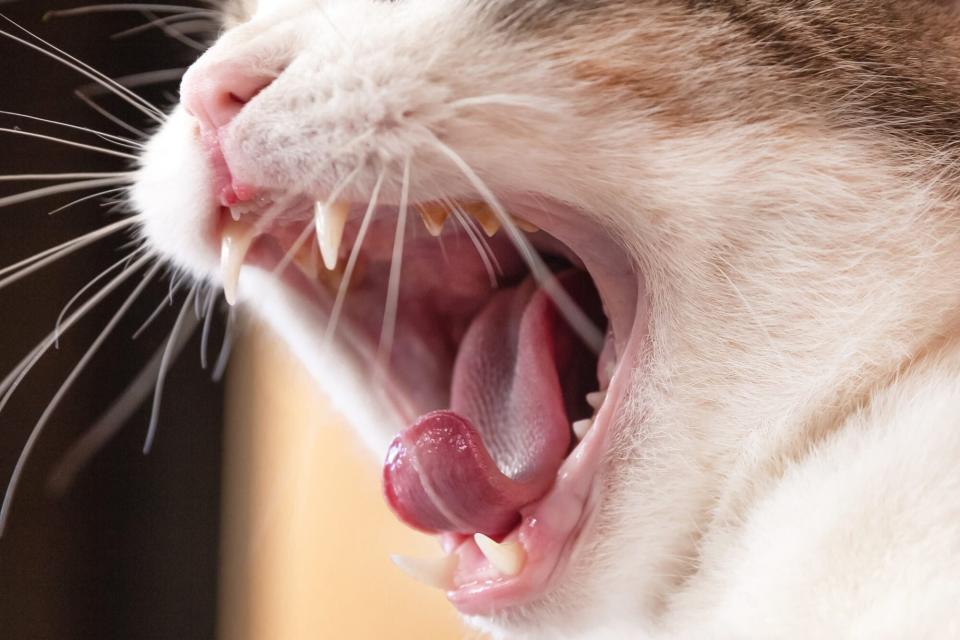Stomatitis in Cats: Symptoms, Treatment, and Caring for Your Kitty's Mouth
Dotdash Meredith and Yahoo Inc. may earn commission or revenue on some items through the links below.
When you give your cat a treat, she usually gobbles it up right away. Nom nom nom! But if she has trouble chewing or paws at her mouth instead, there might be a dental health issue.
Stomatitis in cats, also known as feline chronic gingivostomatitis (FCGS), is a painful inflammatory condition that requires immediate veterinary attention. While often difficult to treat, an early diagnosis and a comprehensive care plan can help kitties regain a better quality of life.

Elena / Adobe Stock
What Is Stomatitis in Cats?
Tarina L. Anthony, DVM, is a longtime practitioner of feline-exclusive medicine, and owner and medical director of Aurora Cat Hospital and Hotel in Aurora, Colo. She says stomatitis in cats is a painful swelling of their gums and other oral tissues. Stoma means cavity and -itis means inflammation. Left untreated, it can lead to periodontitis (bone loss) and subsequent tooth loss.
Now, you may be bribing kitty with yummy pet toothpaste for regular teeth brushing, and using cat dental treats and snackable dental toys to keep her teeth in top rowr health. Don't stop! However, Anthony says there's really no way to prevent this disease, as the veterinary community doesn't know exactly what causes stomatitis.
"We think the cat's immune system is overreacting to the plaque or possibly oral bacteria or viruses," she says. "The prevailing theory is that the etiology is multifactorial—meaning there are likely many contributing causes."
According to MSPCA-Angell, recent research suggests calicivirus (which affects the oral cavity) as a possible contributing factor for FCGS. "Other viruses that can further affect a cat's immune system, such as feline leukemia virus and feline immunodeficiency virus, have not been directly linked to the condition, but may play a role." However, stomatitis in cats isn't contagious to humans or other animals.
Additionally, while gingivitis is in the clinical name, stomatitis is another condition. "An oral exam reveals swollen, red gum tissue along the margin of the tooth and inflammation in the back of the mouth," Anthony says. "Typically, the teeth don't have much tartar on them, which is different from gingivitis that's reactive to tartar and plaque and doesn't affect the other areas of the mouth."
Symptoms of Stomatitis in Cats
Stomatitis in cats isn't deadly, but it's incredibly painful. "Think about going to the dentist and how your gums can ache a bit after a cleaning," Anthony says. "It's similar to that but much more severe."
She says symptoms of stomatitis often include:
Bad breath, which is usually the first sign a pet parent notices
Drooling, sometimes with blood present
Pawing at the mouth, even when not eating
Difficulty eating and dropping food while eating
Although you might think this is a senior cat health issue, Anthony says stomatitis frequently happens in younger cats, too. If you suspect your itty-bitty-kitty has a problem, Anthony says it's imperative to seek veterinary care right away.
And here's the kicker: "sometimes, there are no clinical signs at all, which is why regular veterinary exams are so critical," she adds.
RELATED: 8 Reasons Why Your Cat Might Be Losing Weight
Cat Stomatitis Treatment
As much as we'd like to tell you there are natural home remedies for stomatitis, Anthony says there really aren't effective ones. If you're already keeping up with regular dental care, that's good for your cat overall. However, be careful.
"Sometimes frequent, thorough brushing and at-home care can help, but this is often very challenging to pet parents because brushing is painful for the cat, and it must be done very regularly," she says.
Initial professional treatment recommendations for stomatitis might include anti-inflammatory medications, antibiotics, and antivirals, but Anthony says they have inconsistent results at best.
There's not a cure for this disease, either. So stomatitis in cats treatment is rather extreme: full-mouth extraction, or FME. This is where all the teeth—or in less severe cases, just the premolars and molars—are extracted. Meooooww!
Unfortunately, stomatitis in cats after tooth extraction is still hard to control, and Anthony says the inflammation may take several months to fully resolve. "One study reported only about 50 percent of cats who had FME had a full resolution of symptoms, with the remaining half needing medical management with varying response," she notes. "But I've personally seen a much higher percentage of success than that."
FME might seem like a drastic resolution, but it takes away the pain, and helps improve kitty's life. "Almost every cat parent tells me that they had no idea how much pain their pet was in until they saw how much happier they were afterward," Anthony says. "And yes, they can eat just fine, if not better than before."
RELATED: 10 Ways to Keep Your Cat Healthy

